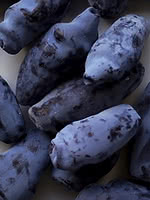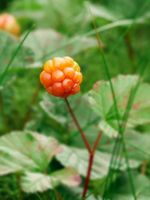Mon-Fri 9am - 5pm Mountain time
Aurora Haskap (Honeyberry) vs Cloudberry
Lonicera caerulea Aurora
Rubus chamaemorus
NOT AVAILABLE THIS SEASON - MIGHT RETURN
Aurora Haskap is considered one of the top Haskap varieties, known for its excellent flavour and lower acidity, resulting in a sweeter taste. The flavour of Haskaps is generally described as a cross between a blueberry and a raspberry. Aurora Haskaps are well suited to fresh eating, freezing, baking, and preserves.
It produces high yields of large berries and the upright growth habit makes it suitable for mechanical harvesting. The berries are easily seen on the bush, making them easy to pick.
For optimal fruit production, cross-pollination is required. Haskaps need to be planted with a compatible variety. Compatibility is influenced by both bloom time and genetics.
Aurora Haskap is an early-pollinating variety and pairs well with Borealis, Tundra, Honey Bee, and Indigo Gem.
Cloudberry produces berries which taste tart and tangy with a sweet, floral hint. The berries have a creamy texture when overripe. They are often used to make jams, juices, and liquors. The berries are a pale red colour and when ripe turn more orange/amber. They do not grow very tall, generally reaching only 10-25 cm.
Cloudberry has distinct male and female plants. In order to produce berries, both must be present and pollinate with each other. Berries are produced at maturity, typically 5-7 years, and produce 1 berry per stem. The plant spreads naturally as they grow using modified underground stems (rhizomes), forming more plants over time in the same area.
This plant can be found wild in Canada’s boreal forest. In Newfoundland and Labrador, this plant is known as the Bakeapple and is a significant regional food. Similarly the Côte-Nord region of Quebec also has a long history of using this berry.
Note: Cloudberries require very specific soil conditions. They need well-drained soil with a pH between 3.5 and 5.0. Also sensitive to salt and dry conditions.
Note: Our seedlings are grown from seed and are too young to identify their sex.

